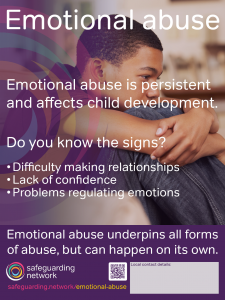Introduction
Emotional abuse can seriously damage a child’s health and development. Children who are emotionally abused may also experience other forms of abuse at the same time. The key element is persistent maltreatment that has long-term effects. Every parent gets things wrong from time to time, but repeated behaviours, such as those described further down this page, are abusive.
Need more?
Thank you for visiting our resources pages. These are free to everyone as is our fortnightly safeguarding bulletin – general safeguarding information is too important to restrict. Become a member to access lots more, including training materials for you to deliver in-house on each topic in Keeping Children Safe in Education.
Sign up for FREE fortnightly bulletin.
What about training?
We can deliver training for your setting on this and other subjects via online platforms, or face-to-face in certain areas. Just get in touch to discuss your requirements.
Statistics
- Research by the NSPCC with 2,275 young people aged 11-17 about their experiences of emotional abuse suggests around 1-in-15 children in the UK have been emotionally abused. Childline reports that over 11,000 contacts to the helpline and almost 5,000 Childline counselling sessions in 2020/21 were about emotional abuse.
- According to the Office for National Statistics (ONS), the Crime Survey for England and Wales (CSEW) estimated that 1-in-11 adults aged 18 to 74 years experienced emotional abuse before the age of 16. The abuse was most commonly perpetrated by the child’s parent(s).
- Children in need reporting figures for 2023 suggest emotional abuse accounts for around 25% of children in need and around 37% of children on child protection plans.
Definition
“The persistent emotional maltreatment of a child such as to cause severe and adverse effects on the child’s emotional development.”
Emotional abuse may involve communicating to children that they are worthless, inadequate or unloved, including not giving them the opportunities to express their views, deliberately silencing them or ‘making fun’ of what they say or how they communicate. It may include imposing unreasonable expectations on a child which are inappropriate for their age and stage of development.
It may also involve over protection, limiting exploration and learning opportunities and/or chances for normal social interactions. It also includes the child feeling frequently frightened or in danger, being bullied by peers or other children (e.g., child-on-child abuse) or witnessing the ill-treatment of others (e.g., domestic abuse).
Spot the signs
Signs may include the following (this is not an exhaustive list):
Physical indicators:
- delays in physical development, e.g., milestones delayed, being underweight, experiencing unusual lethargy;
- marks on their body from self-harm.
Behaviour indicators:
- lack of confidence, withdrawn, wary or anxious;
- lacking a close relationship with a parent/carer;
- over reactions to mistakes;
- continual self-deprecation;
- sudden speech disorders;
- wetting/soiling themselves or bedding;
- social isolation (may not mix well or has few friends);
- extremes of compliance, passivity and or aggression/provocativeness;
- compulsive stealing;
- rocking, thumb sucking, hair twisting, etc.;
- drug, alcohol or solvent misuse;
- inability to play;
- fear of/anger towards a particular member of staff;
- fear of parents being contacted.
Additional vulnerabilities
Any child can be emotionally abused. Some children and young people are more vulnerable to abuse, including those with parents or carers who:
- are stressed and under pressure, and become emotionally unavailable to their children;
- are experiencing post-natal depression;
- may have unrealistic expectations about their child’s ability;
- have relationship problems and/or family arguments;
- are experiencing poverty, money problems or unemployment;
- are experiencing/perpetrating domestic abuse;
- misuse drugs and alcohol;
- suffer from mental health issues without sufficient support.
What to do
Create an environment based on equality and informed choice – help children/young people think about the issues and attitudes behind emotional abuse and bullying particularly concerning gender and other equality issues. Ensure you have an environment where bullying and other concerns about other children or staff are dealt with swiftly and consistently.
Ensure young people know the risks – talk about emotional abuse in an age-appropriate way.
Check young people have safe relationships – in their family, with their peers, with other children and with your staff. Who would they talk to if they were worried or unhappy? Create an environment where it is okay to talk, even about the most difficult things.
Know the signs and know what to do – use the checklists above, your safeguarding procedures and be confident to raise emotional abuse as a possibility. Talk with your DSL and deputies to help them analyse what you have noticed and the likely impact so as to decide what to do.
Keep a chronology – record the incidents of concern and build up a picture of the child/young person’s life. Analyse the impact and consider whether their emotional, developmental and academic progress is what you would expect of a similar child/young person.
Take action – and keep taking action until you know they are safe.
Free emotional abuse poster
This free, downloadable resource raises the profile of safeguarding for your staff team. For use in staff rooms, on safeguarding boards or on the back of toilet doors, the poster includes tips, a space for local contact details, plus a link and QR codes to this resource page. Download the poster from the resources below.
DSL Training Materials
-

Presentation
-

Presenter Notes
-

Handout for staff
-

Emotional Abuse – Quiz
-

Emotional Abuse – Quiz (answers)
-

Emotional abuse scenario – EYFS
-

Emotional abuse scenario (EYFS) – DSL information sheet
-

Emotional abuse scenario (primary schools)
-

Emotional abuse scenario (primary schools) – DSL information sheet
-

Emotional abuse scenario – secondary schools
-

Emotional abuse scenario (secondary schools) – DSL information sheet
-

Emotional abuse scenario – 16+ settings
-

Emotional abuse scenario (16+) – DSL information sheet
-

Emotional abuse scenario – SEND settings
-

Emotional abuse scenario (SEND) – DSL information sheet
-

Emotional abuse scenario – Care
-

Emotional abuse scenario (Care) – DSL information sheet
Resources
-

Emotional abuse poster
-

Protecting children from emotional abuse
-

Childline – Healthy and unhealthy relationships
Save time and improve your safeguarding approach…
Bite-size training materials to share with your staff every month.
Support to explore and develop your safeguarding culture.
A huge array of resources and professional experience at your fingertips.
Get in touch now for a personal tour of the site and details of membership benefits.
We look forward to working with you.


